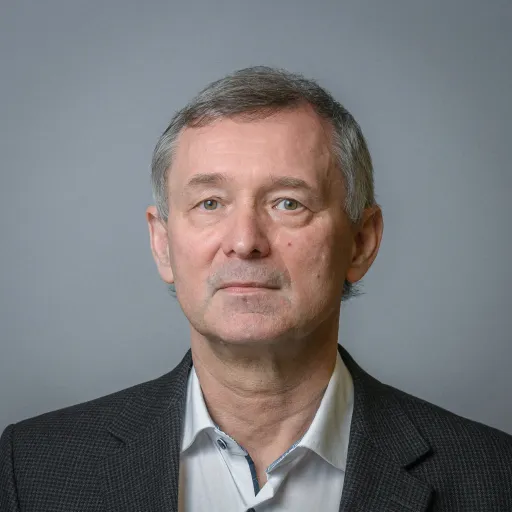
Tamás Szirányi, Prof.
WebPage: http://www.sztaki.hu/~sziranyi/
Publication lists:
Scientific positions
- Corresponding member of theHungarian Academy of Sciences from 2022
- Research Professorwith the Institute for Computer Science and Control (HUN-REN SZTAKI)
- Head of Machine Perception Research Laboratory (MPLab)
- Professor (emeritus)with the Budapest University of Technology and Economics, Faculty of Transportation Vehicle & Engineering from 2014 (2022)
- Fellow of IAPR from 2008 (see Getting to know...Tamás Szirányi, IAPR Fellow)
- Elected Fellow of Asia-Pacific Artificial Intelligence Association (AAIA) .
- Elected member of European Laboratory for Learning and Intelligent Systems (ELLIS),
- Senior member of IEEE
- Member of the Hungarian Academy of Engineering from 2008
- Associate Editor of Digital Signal Processing from 2011
- Area Editor of Digital Signal Processing from 2021
- Associate Editor of Infocommunication Journal from 2017
pastpositions
- Member of Council of Research Institutes of the Academy (MTA AKT) (2008 - 2015)
- Hungarian Academy of Sciences from (2007- 2012)
- Member of the board of Trustees of Bolyai Research Fellowship (2007- 2012)
- Former Professor with the Péter Pázmány Catholic University, Dep of Information Technology (2004-2014)
- Former Professor with the Veszprém (Pannon) University, head of Image Processing Lab (2001-2011)
- Associate Editor of IEEE Tr. Image Processing (2003-2009)
- Representative of Doctors of the
Biography
Prof. Tamás Szirányi received his Ph.D. and D.Sci. degrees in 1991 and 2001, by the Hungarian Academy of Sciences, Budapest. He was appointed to a Full Professor position in 2001at Pannon University, Veszprém, Hungary, and, in 2004, at the Péter Pázmány Catholic University, Budapest. Presently he is a full professor at the Budapest University of Technology and Economics.
He has been a research scientist at the Institute for Computer Science and Control (MTA SZTAKI), Hungarian Academy of Sciences since 1992, where he leads the Machine Perception Research Laboratory (earlier Distributed Events Analysis Res Lab) since 2006. With his research laboratory he has been participated in several prestigious international (ESA, EDA, FP6, FP7, OTKA) projects. The main topics with his laboratory are: Earth observation, Robot localisation, Geo-information computation, Surveillance camera networks.
Dr. Szirányi was the founder and past president (1997 to 2002) of the Hungarian Image Processing and Pattern Recognition Society. He was an Associate Editor of IEEE T. Image Processing (2003-2009), and he has been an AE of Digital Signal Processing (Elsevier) since 2012. He was honoured by the Master Professor award in 2001, by the Széchenyi professorship and the ProScientia (Veszprem) award in 2011. He is a Fellow both of the Int. Assoc. Pattern Recognition (IAPR) and the Hungarian Academy of Engineering from 2008. He has been elected as a Corresponding Member of the Hungarian Academy of Sciences in 2022. He has more than 300 publications including 60 in major scientific journals, and several international patents.
Research activities include:
- machine perception,
- pattern recognition,
- autonomous driving,
- 3D image analysis,
- texture and motion segmentation,
- Markov Random Fields and stochastic optimization,
- remote sensing,
- Earth observation,
- surveillance systems for multiple cameras,
- intelligent networked sensor systems,
- graph based clustering,
- digital film restoration.
Awards
- Michelberger Master Award, Hungarian Academy of Engineering (2020)
- Officers’Cross by the President of Hungary (2018)
- ProScientia (Pannon Uni, 2011)
- Master professor (2001)